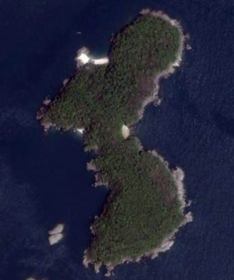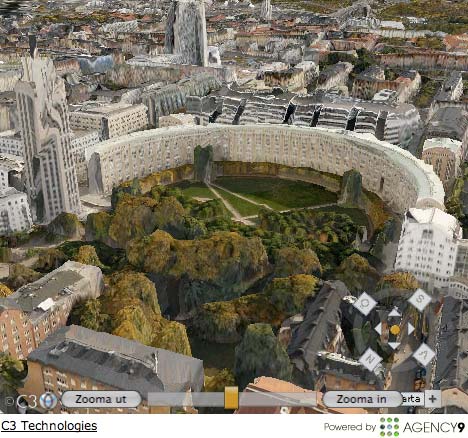- The happiest place on Earth: The happiest place on Earth is this island, according to the BBC.
- North Korea Intel: North Korea Economy Watch‘s meticulously researched KML layer pinpointing every conceivable feature in North Korea, including the gulags, nuclear sites, military sites and elite areas, has just been updated. What’s causing a bit of a tizzy is the discovery of an island that looks remarkably like Korea:

Well, it’s not an exact miniature, but it looks completely natural, and I can appreciate that if you’ve been staring at maps of Korea all day while making this layer, these kinds of similarities will pop out at you:-) Find it in the “Other Stuff” folder of the KML file. (Via DPRK Studies, via ROK Drop)
- iPhone to get GPS? GigaOm has sources giving the GPS chipset contract for the next iPhone to Broadcom, which corroborates other circumstantial evidence of a GPS-enabled iPhone: Built-in photo geotagging, and VC funding for Pelago’s Whrrl, a location-based context service for the iPhone.
- Test ad for Google Sky: This Google ad was recently spotted on Ogle Earth:-)

- F-Secure: Finnish internet security firm F-Secure monitors the origins of worms, spam and malware using Google Earth.
- Where 2.0 Disaster tech video: O’Reilly Radar has the video of the Disaster Tech talk at Where 2.0 by Jesse Robbins and Mikel Maron, and links through to pretty much all projects and organizations currently involved in pushing this envelope.
- Hasselblad’s Phocus: Hasselblad, makers of the drool-inducing GPS-capable 39 megapixel H3DII DSLR camera, has now gotten its own dedicated RAW image processing software. Phocus (Mac only at the moment, Windows version promised) looks superficially similar to Apple’s Aperture, and can produce KML for a photo with coordinate metadata to show it on Google Earth. (At these prices, shouldn’t it do more, such as create smart collections based on proximity searches?)
Below, some more early adopters of the Google Earth view in the Browser. No cases yet of interesting uses of the API, but any week now…
- Metropix: Metropix, the automated floor-plan-to-3D service, now also shows the results of its service via the Google Earth plugin embedded. For example.
- GIS Planning: GIS Planning Inc has added the embedded Google Earth view to a number of Google Maps sites it has developed, such as Nevada Site Search.
- Tagzania: The developers behind geobookmarking site Tagzania, currently hard at work on behind-the-scenes changes, nevertheless took the time to add the 3D embedded Google Earth view for maps of individual locations: Here’s a 2D example, and here is the 3D equivalent.

